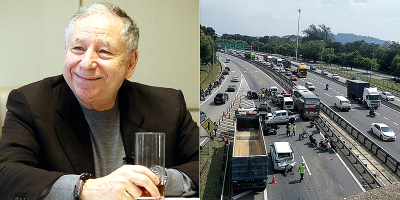
Road safety remains a major priority in Malaysia.
With increasing vehicles and population, exposure to road traffic is increasing in an exponential manner.
All of us are pedestrians in some ways with usage of the roads obligatory for our daily needs.
All road users have legal requirements to meet before making use of the road in any capacity (whether as driver/rider of any vehicle, pillion/passenger or pedestrian).
The author reviewed relevant Malaysian road safety laws in the context of scientific understanding of road crash causation and prevention according to the World Health Organization Report on Road Traffic Injury Prevention to which he had contributed.
The relevant Malaysian laws/sections and statements from the WHO report are quoted verbatim for better understanding of their stands.
Section 41 of Act 333 of the Road Transport Act 1987 (with its subsequent amendments) states that “any person who, by the driving of a motor vehicle on a road recklessly or at a speed or in a manner which having regard to all the circumstances (including the nature, condition and size of the road, and the amount of traffic which is or might be expected to be on the road) is dangerous to the public, causes the death of any person shall be guilty of an offence and shall on conviction be punished with imprisonment for a term of not less than two years and not more than ten years and to a fine not less than five thousand ringgit and not more than twenty thousand ringgit.”
Sections 42 and 43 are similar to Section 41 in their intention and content.
The WHO Report states the following: “the traditional view on road safety has been that when crashes occur, they are usually the sole responsibility of individual road users, despite the fact that other factors beyond their control may have come into play, such as the poor design of roads or vehicles; “….indirect influences, such as the design and layout of the road, the nature of the vehicle, and traffic laws and their enforcement – or lack of enforcement – affect behavior in important ways…”; “.. errors can also be effectively reduced by changing the immediate environment, rather than focusing solely on changing the human condition…”.
The author’s interpretation of the above is as follows.
The law tends to correlate the crash outcomes directly with driving behavior. The WHO Report emphasizes multidimensional etiologic factors contributing to the crashes.
The interpretation of the law, its perceived societal deterrent impact, crash outcomes and potential emphasis on some contributory factors over others, all affect legal judgement and sentence meted.
The WHO Report synthesizes the world evidence for “what works for prevention.”
Hence, there needs to be a “middle ground” in the interpretation and understanding of the above “seemingly opposing” stands.
In order to achieve any success in road safety i.e. effect reduction in road traffic deaths, legislators, enforcers and policy makers need to amalgamate the global scientific evidence with the laws to enforce road safety measures in our milieu.
(Dr. Krishnan Rajam is Senior Professor at AIMST University. He was a former Technical Officer (Injury Prevention) at the WHO Western Pacific Regional Office and contributed to the World Health Organisation Report on Road Traffic Injury Prevention.)
ADVERTISEMENT
ADVERTISEMENT





































